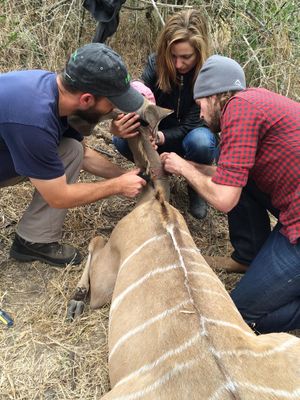UI wildlife researcher awarded $700K to study Africa antelope
WILDLIFE -- A University of Idaho researcher in has received a $700,000 grant from the National Science Foundation to continue studying antelope in Africa.
The ongoing study involving the College of Natural Resources looks at body size and how it impacts behavior and survival of native antelope in Gorongosa National Park in Mozambique, Africa.
Here's more from a university media release:
Lead investigator Ryan Long, an assistant professor in the University of Idaho’s Department of Fish and Wildlife Sciences, and co-investigators Rob Pringle and Corina Tarnita, both assistant professors at Princeton University, have been studying the large herbivore communities in Gorongosa since 2013. All together, the researchers were awarded $1.25 million from the NSF for the work.
The study will focus on three closely related antelopes that differ considerably in body size: bushbuck, nyala and kudu. In the wild, availability of resources such as food, water and shelter fluctuates constantly. Animals must adjust their behavior in response to changing environmental conditions in order to survive and reproduce. Data gathered during this project will help researchers understand how variation in body size limits animals’ ability to respond to changes in the environment, such as the availability of food or water. While the information gathered will be important for determining the best conservation and management practices in Gorongosa, it could also be useful for understanding North American species of varying sizes, such as deer, elk and moose.
"Body size influences nearly every aspect of animal behavior and performance, and striking variation in size among species is a defining feature of the animal kingdom“ Long said. “In addition, variation in the availability and quality of resources presents a ‘puzzle’ that nearly every animal has to solve in order to successfully survive and reproduce. Our research will build on several years of previous data collection at Gorongosa in a number of different ways — a powerful combination of experimental and model-based approaches will allow us to provide new insights into the relationships among body size, behavior and environmental variation.”
Nearly 99 percent of the large animals in Gorongosa National Park were killed during 16 years of civil war in Mozambique, which ended in the early 1990s. In 2008, the Carr Foundation — a nonprofit established by Idaho businessman Greg Carr — began supporting science and restoration in the park. After almost a decade of work supported by the foundation, Gorongosa again has some of the most diverse animal populations in Africa. The collaboration among the Mozambican government, scientists, community members and stakeholders is not only rebuilding the park, but also dramatically influencing the local economy through tourism and education. Long started working with the Carr Foundation while he was a postdoctoral researcher at Princeton, and has continued that collaboration after joining the faculty at UI.
This new project being funded by NSF builds upon the successful research, conservation and education already happening in the park. The research team includes staff from the U.S. and Mozambique and an immersive field course will be developed and taught to students from both countries, promoting additional collaborative efforts.
This project, “Collaborative Research: Allometry of Behavior in Spatially Patterned Resource Landscapes,” was funded under National Science Foundation grant No. 1656642. The total amount of federal funds for the project awarded to UI is $700,000, which amounts to 100% of the total cost of the project. The total amount of non-federal funds for the project is zero, which amounts to 0% of the total cost of the project.
